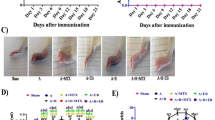Background and Purpose:
Low-dose radiotherapy is widely accepted as a very effective treatment option for inflammatory symptoms associated with painful degenerative joint disorders. Radiation doses and fractionation schedules in practical use are empirical and mainly based on clinical observations. Experimental data are rare. The efficacy of low-dose X-irradiation on adjuvant induced arthritis in rats using different fractionation schemes was investigated in vivo, in order to explore whether there is a dose and fractionation dependence.
Material and Methods:
Adjuvant arthritis in female Lewis rats (n = 128) was induced by intradermal injection of heat-inactivated Mycobacterium tuberculosis on day 0. Both arthritic hind paws were sham-irradiated (group 1: days 10–14; group 2: days 15–19; group 3: days 22–26) or X-irradiated with either 5 × 1.0 Gy (group 4: days 10–14; group 6: days 15–19; group 8: days 22–26; group 10: days 10, 12, 14, 16, and 18) or 5 × 0.5 Gy (group 5: days 10–14; group 7: days 15–19; group 9: days 22–26; group 11: days 10, 12, 14, 16, and 18; group 12: days 10–14 and 22–26). The clinical parameters arthritis score (AS), hind paw volume (HPV), and body weight were determined.
Results:
A significant decrease of the clinical arthritis parameters was observed following 5 × 0.5 Gy or 5 × 1.0 Gy during the acute maximum of the inflammatory response (days 15–19). The most pronounced treatment effect was reached after two daily fractionated series of 5 × 0.5 Gy with an early treatment onset (days 10–14) and repetition in interval (days 22–26). After the application of 5 × 1.0 Gy on days 10–14 or in a protracted scheme (days 10, 12, 14, 16, and 18), only a nonsignificant positive trend could be detected. Daily fractionated X-irradiation in the chronic phase of adjuvant arthritis (days 22–26) did not show any positive clinical effect.
Conclusion:
Low-dose radiotherapy is able to prevent a full-blown arthritic reaction if given during the florid phase of adjuvant arthritis. Two series of 5 × 0.5 Gy with an early treatment onset (days 10–14) and repetition in interval (days 22–26) were the most effective treatment schedule in this experimental study.
Hintergrund und Ziel:
Die niedrig dosierte Strahlentherapie wird als effektive Behandlungsoption bei schmerzhaften, entzündlich reaktivierten degenerativen Gelenkerkrankungen angesehen. Die verwendeten Einzeldosen und Fraktionierungen basieren im Wesentlichen auf klinisch-empirischen Beobachtungen. Experimentelle Untersuchungen sind sehr selten. Das Ziel dieser Studie war die Beurteilung der klinischen Wirksamkeit verschiedener Fraktionierungsschemata und Einzeldosen in einem experimentellen Arthritismodell der Ratte, um zu überprüfen, ob eine Dosis- oder Fraktionierungsabhängigkeit vorliegt.
Material und Methodik:
Bei weiblichen Lewis-Ratten (n = 128) wurde durch intradermale Injektion von hitzeinaktiviertem Mycobacterium tuberculosis am Tag 0 eine Adjuvansarthritis induziert. Beide Hinterpfoten arthritischer Versuchstiere wurden scheinbestrahlt (Gruppe 1: Tage 10–14; Gruppe 2: Tage 15–19; Gruppe 3: Tage 22–26) oder lokal bestrahlt mit entweder 5 × 1,0 Gy (Gruppe 4: Tage 10–14; Gruppe 6: Tage 15–19; Gruppe 8: Tage 22–26; Gruppe 10: Tage 10, 12, 14, 16 und 18) oder 5 × 0,5 Gy (Gruppe 5: Tage 10–14; Gruppe 7: Tage 15–19; Gruppe 9: Tage 22–26; Gruppe 11: Tage 10, 12, 14, 16 und 18; Gruppe 12: Tage 10–14 und 22–26). Die klinischen Parameter Arthritisscore (AS), Hinterpfotenvolumen (HPV) und Körpergewicht wurden im Verlauf bestimmt.
Ergebnisse:
Nach 5 × 0,5 Gy oder 5 × 1,0 Gy während des akuten Entzündungsmaximums (Tage 15–19) konnte eine signifikante Reduktion der klinischen Arthritisparameter beobachtet werden. Der günstigste Behandlungseffekt wurde mit zwei täglich fraktionierten Serien von 5 × 0,5 Gy bei frühzeitigem Behandlungsbeginn (Tage 10–14) und Wiederholung im Intervall (Tage 22–26) erreicht. Nach 5 × 1,0 Gy an den Tagen 10–14 oder in einem protrahierten Schema (Tage 10, 12, 14, 16 und 18) war lediglich ein nichtsignifikanter positiver Trend nachweisbar. Die tägliche fraktionierte Bestrahlung in der chronischen Phase der Adjuvansarthritis (Tage 22-26) zeigte keinen positiven klinischen Effekt.
Schlussfolgerung:
Eine niedrig dosierte Strahlentherapie ist in der Lage, die volle Ausprägung einer arthritischen Reaktion zu verhindern, wenn sie während der floriden Phase der Adjuvansarthritis appliziert wird. In dieser Studie waren zwei Bestrahlungsserien von 5 × 0,5 Gy mit frühzeitigem Behandlungsbeginn (Tage 10–14) und Wiederholung im Intervall (Tage 22–26) das effektivste Behandlungsschema.
Similar content being viewed by others
Author information
Authors and Affiliations
Corresponding author
Rights and permissions
About this article
Cite this article
Liebmann, A., Hindemith, M., Jahns, J. et al. Low-Dose X-Irradiation of Adjuvant-Induced Arthritis in Rats. Strahlenther Onkol 180, 165–172 (2004). https://doi.org/10.1007/s00066-004-1197-2
Received:
Accepted:
Issue Date:
DOI: https://doi.org/10.1007/s00066-004-1197-2




